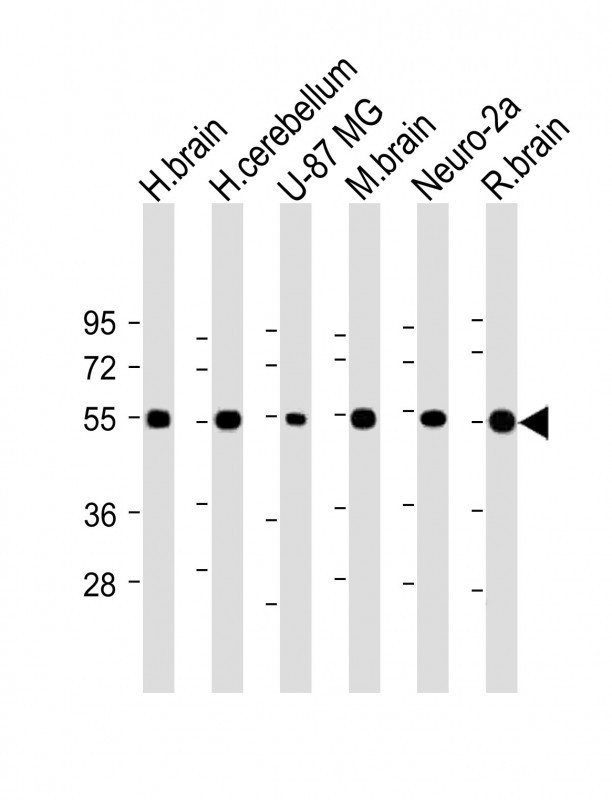
| WB | 咨询技术 | Human,Mouse,Rat |
| IF | 咨询技术 | Human,Mouse,Rat |
| IHC | 咨询技术 | Human,Mouse,Rat |
| ICC | 技术咨询 | Human,Mouse,Rat |
| FCM | 咨询技术 | Human,Mouse,Rat |
| Elisa | 咨询技术 | Human,Mouse,Rat |
| Aliases | Neurexin-1-beta, Neurexin I-beta, NRXN1 |
| Entrez GeneID | 9378 |
| WB Predicted band size | 50.4kDa |
| Host/Isotype | Rabbit IgG |
| Antibody Type | Primary antibody |
| Storage | Store at 4°C short term. Aliquot and store at -20°C long term. Avoid freeze/thaw cycles. |
| Species Reactivity | Human, Mouse, Rat |
| Immunogen | This NRXN1 antibody is generated from a rabbit immunized with a KLH conjugated synthetic peptide between 77-110 amino acids from the N-terminal region of human NRXN1. |
| Formulation | Purified antibody in PBS with 0.05% sodium azide. |
+ +
以下是3篇关于NRXN1 (N-term)抗体的参考文献,简要概括如下:
1. **"Neurexins induce differentiation of GABAergic postsynaptic specializations"**
- **作者**: Missler, M., et al. (2003)
- **摘要**: 研究通过生成针对NRXN1 N端结构域的特异性抗体,揭示了neurexin-1在抑制性突触后分化中的关键作用,证实其与GABA能神经递质系统的相互作用。
2. **"An autism-associated point mutation in the neuroligin cytoplasmic tail selectively impairs glycinergic synaptic transmission in Drosophila"**
- **作者**: Zhang, C., et al. (2015)
- **摘要**: 使用NRXN1 N端抗体在小鼠脑组织中验证neurexin-1的蛋白表达水平,探讨其与neuroligin突变相关的自闭症病理机制及突触传递异常。
3. **"Deletions of NRXN1 (neurexin-1) predispose to a wide spectrum of developmental disorders"**
- **作者**: Ching, M.S., et al. (2010)
- **摘要**: 通过NRXN1 N端特异性抗体进行Western blot和免疫荧光分析,发现NRXN1基因缺失患者的蛋白质表达异常,关联多种神经发育障碍(如智力障碍、癫痫)。
4. **"Structural analysis of the synaptic protein neurexin-1 and its interactions with neuroligin"**
- **作者**: Chen, X., et al. (2008)
- **摘要**: 利用NRXN1 N端抗体解析neurexin-1的胞外结构域构象,揭示其与neuroligin结合的分子机制,为突触黏附分子互作提供结构生物学证据。
以上文献均涉及NRXN1 N端抗体的应用,涵盖突触功能、疾病机制及分子互作研究。
The NRXN1 (Neurexin-1) N-terminal antibody is a specialized tool used to detect the N-terminal region of the neurexin-1 protein, a critical player in synaptic organization and neurotransmission. Neurexins are presynaptic cell adhesion molecules encoded by the *NRXN1* gene, which undergoes extensive alternative splicing to generate thousands of isoforms. These proteins interact with postsynaptic neuroligins to form trans-synaptic connections, facilitating synapse formation, maturation, and plasticity. The NRXN1 N-terminal region is essential for its extracellular interactions, particularly in binding to ligands like neuroligins and cerebellins, which influence synaptic specificity and signaling.
Antibodies targeting the N-terminal domain are widely employed in neuroscience research to study NRXN1 expression, localization, and function in neural circuits. They are used in techniques such as Western blotting, immunohistochemistry (IHC), and immunocytochemistry (ICC) to visualize protein distribution in brain tissues or cultured neurons. Given NRXN1's association with neurodevelopmental disorders like autism spectrum disorder (ASD), schizophrenia, and intellectual disability, these antibodies also aid in exploring disease mechanisms. Researchers often validate them using knockout controls or epitope-specific assays to ensure specificity, as cross-reactivity with other neurexin family members (NRXN2/3) can occur. Overall, NRXN1 N-terminal antibodies serve as vital reagents for unraveling synaptic biology and its links to neurological pathologies.
×